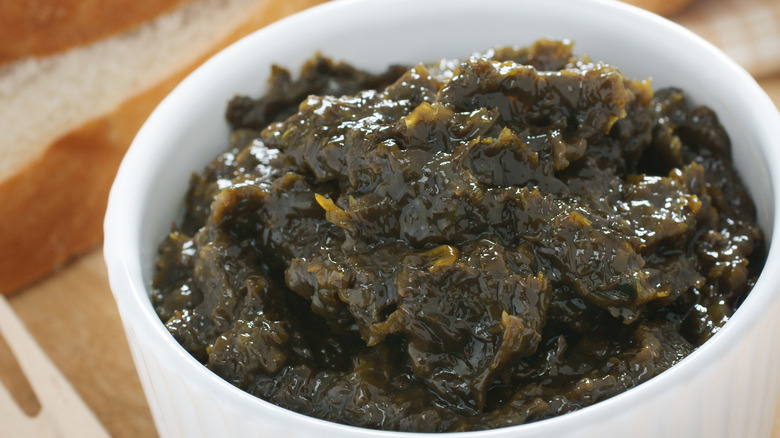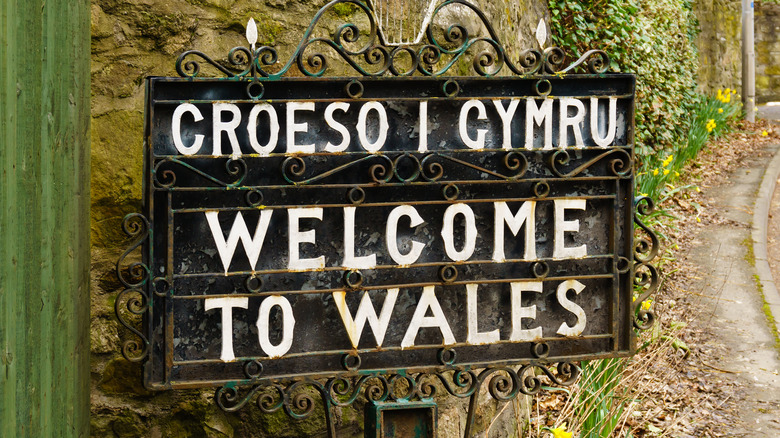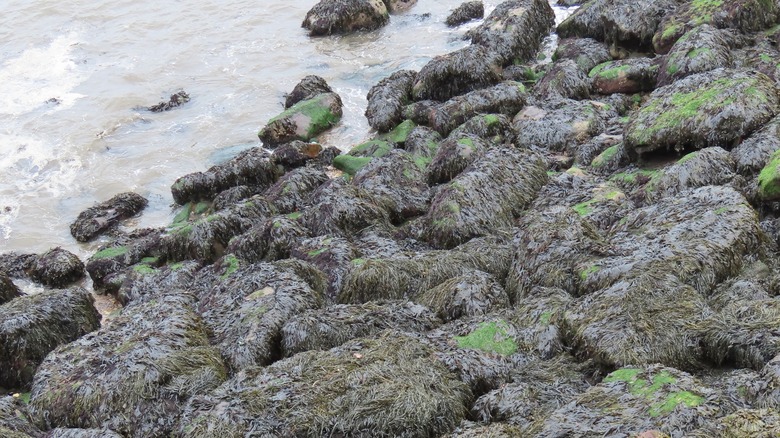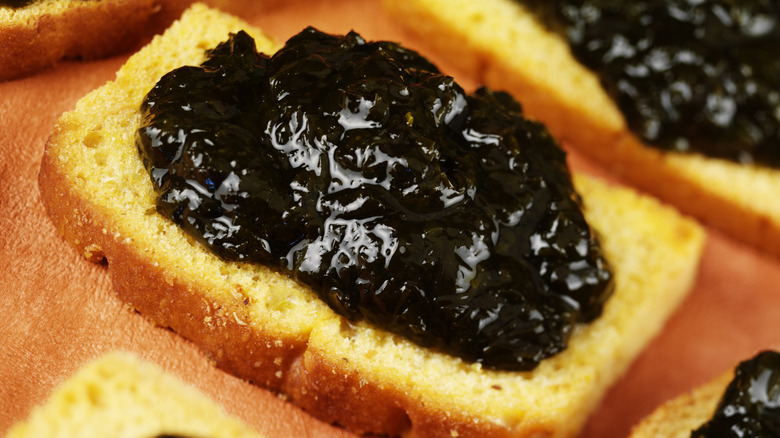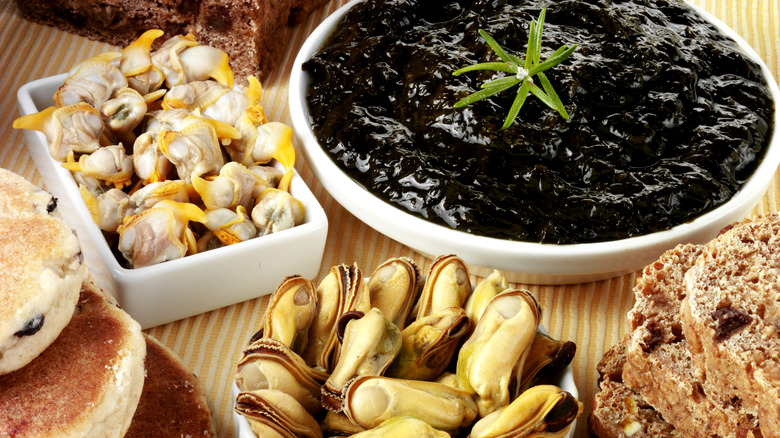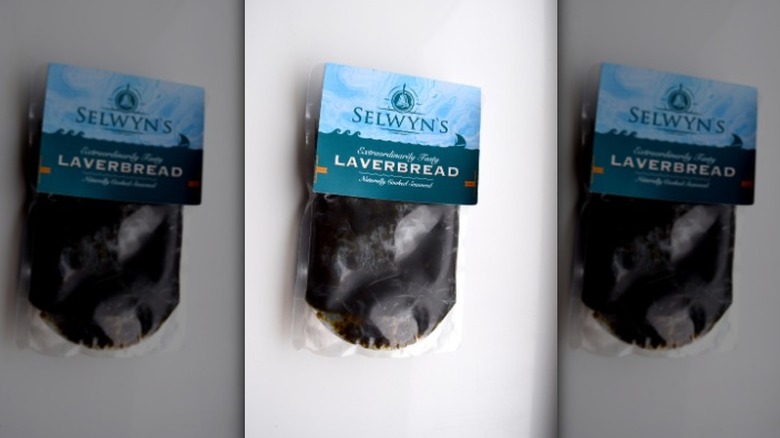Welsh Laverbread Isn't Actually Bread. Here's How It's Made
Of all the world's most famous breakfasts, one of the most notable has to be the traditional English breakfast. Called a fry-up in the United Kingdom, a full English breakfast consists of fried eggs, black bacon, sausages, fried tomatoes, mushrooms, fried bread, and a slice of black or white pudding, served with coffee or tea, and some buttered toast. If that sounds like a lot, it is.
The English breakfast is undeniably far too big a meal to consume every day, especially by modern standards. However, if your day was destined to be spent in the fields, out at sea, or deep in the coal mines, a full breakfast like this served as a calorically dense energy booster that gave you all you needed to make it through a long day of work with little or no time to break for lunch.
Across the four nations that make up the United Kingdom, there are different variations on this hearty meal. In Scotland and Northern Ireland, fried bread is replaced with oatcakes and soda bread. The Welsh, however, take a completely different approach to their bread component. Despite the name indicating the presence of glutenous dough, laverbread is not actually bread at all. Traditional Welsh laverbread is, quite literally, pulverized seaweed. Spread on toast, rolled with oats into cakes, or enjoyed on its own, laverbread is a uniquely Welsh creation that offers great insight into the history and culture of this small nation.
Origins of laverbread
Like so many other dishes littered throughout the pages of food history, there is no clear answer to when laverbread began. It is entirely possible that food shortages as a result of Norse invaders caused the Welsh to seek nourishment from the sea. Laver harvesting makes an appearance in the 12th century on the Pembrokeshire Coast, where women were said to have collected it off the rocks and hung it out to dry. Whatever its origin, laverbread remains deeply rooted in Welsh history.
The seaweed paste became a vital, nutritious component of the Welsh breakfast during the 19th century. Miners from south Wales needed the amino acids, vitamin A, vitamin C, protein, iron, iodine, and B12 provided by the laver, though they didn't know the scientific specifics. What they did know was that the laverbread they were consuming was an excellent addition to their already piled breakfasts.
The energy the seaweed provided was essential to helping keep the workers sustained throughout the day. As the sea was never far away from anywhere in Wales, seaweed could be easily foraged and collected and was an inexpensive way to fill bellies. This made laverbread a common staple in the Welsh coastal communities. For example, the coastal city of Swansea has its own distinct take on breakfast, consisting of beautifully steamed cockles, another Welsh delicacy, and laverbread on toast. It makes for a briny breakfast.
What is laverbread?
Laverbread comes in a couple of different forms, but the only ingredient you need to make it is a specific variety of seaweed. Called laver (Porphyra umbilicalis), this seaweed is a type of red algae found off the coast of Scotland, Wales, and Ireland. Though native to the Atlantic Ocean, laver has been cultivated in Asia as well as elsewhere in the Pacific. Coming in a variety of different colors and very similar in shape and size to other seaweed, laver can be difficult to spot at first. However, one of its key features is that it appears to grow straight out of the rocks and has a leafy shape with a wide, floppy, gelatinous body.
Once collected, the seaweed is traditionally dried before being mashed into a pulp. Today, it's boiled for up to 10 hours in order for the seaweed to break down to a point where it is able to be pulverized, for the raw seaweed is actually rather tough and chewy.
The pulp can be served on its own and slathered across bread. However, it is known that the original proponents of laverbread used to eat the paste raw or mix it into their rations of oatmeal. The preferred method among the miners of preparing laverbread, which became very popular elsewhere, is to roll the seaweed paste in oats and form little cakes that get pan-fried in bacon fat. The oats add extra texture, while the bacon brings a salty savoriness.
What's with the name?
Laverbread is really a name in two parts, split cleanly down the middle. The first half, laver, is named after the seaweed. In Welsh, is as spelt "lawr." The second half, bread, or "bara" is a little more difficult to explain. It could be the fact that bara lawr is commonly served on toast, but other written records from centuries past confer a different meaning to the bread moniker altogether.
The 1695 edition of Camden's Britannica described the process of making laverbread as the seaweed being "well-kneaded, as they do for bread, and made up into great balls or rolls." The seaweed, having already been cleaned and shredded, now needed to be broken down into a paste-like consistency. As boiling water was likely not an option for the peasantry of the time, kneading was the only way produce laverbread. This action stands as another possible reason why the moniker was adopted.
Shaping the pulverized seaweed into balls or rolls may also be part of laverbreads association with actual bread. As the mixture was commonly rolled into lavercakes, the end products were almost akin to small biscuits or even thick and soft like English muffins. Though it isn't baked like normal bread, the consistency provided by the oats gives laverbread a unique bready quality.
What does laverbread taste like?
Laverbread has all the qualities one who is familiar with eating seaweed would come to associate with it. The taste is similar to Japanese nori, another common laver product that's usually seen holding together sushi rolls. However, as laverbread is pulverized and boiled, its flavor and texture are going to be different from nori. Laverbread has a briny tang that offers up a full range of salty, iodine-heavy flavors evocative of the sea, and has the soft, easy-to-eat consistency of wilted spinach.
As laverbread is almost condiment-like in its nature, there is a whole array of inventive ways you could think to use it. Laverbread can be used as the base for a seafood pizza topped with cockles as Thomas Straker does for Seasoned Well. You could also try adding it to another Welsh classic, rarebit, by mixing it in with the melty cheese and spreading it on toast.
Laverbread can also be incorporated into cawl, a traditional Welsh stew of meat and vegetables. As sheep are abundant livestock in the Welsh countryside, they are very often the protein of choice. Laverbread is added to cawl to bring a little extra savoriness and brine to the broth. Laverbread can even be used as an accompaniment to roasted meats, much like chimichurri or classic mint sauce.
An enduring legacy
Lest you believe that laverbread is just something anyone, anywhere in the world could produce, you should know that the stuff is protected by the government of the United Kingdom. Much like the Cornish Pasty, Welsh laverbread has Protected Designation of Origin (PDO) status, meaning that only laverbread produced in Wales in the traditional manner laid out by the designation can be labeled as such.
According to specifications related to its PDO, a lot goes into proving the production of the laverbread meets the standards they've set forth. For instance, only fresh laver plucked from the shores, rinses in fresh seawater, cooked in batches for several hours, and with an added salt content of only 1% in the finished product, can be labeled as traditional Welsh laverbread. The cleanliness is of particular concern to producers, as the raw materials necessary to make laverbread are of vital importance to the finished product.
As with other foods across the world that have special ties to the history and culture of a people, the laverbread of Wales speaks to truths universal to all humanity. It says that no matter where you live in the world, edible natural resources are available for you to use. And while harvesting laver may have begun as an exercise in survival, it has become a unique cultural marker of this quiet little corner of the United Kingdom.
